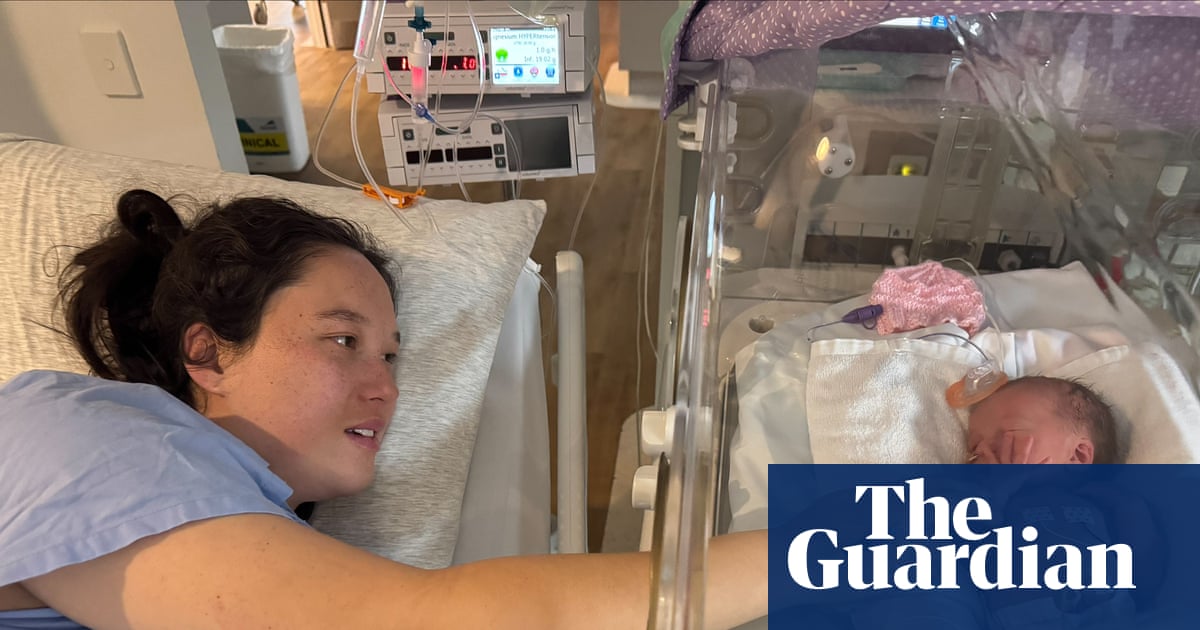When Wendy Andrews went for a routine check-up at 31 weeks and six days pregnant, her blood pressure was dangerously high at 150/120. This signalled pre-eclampsia, a condition that often forces early delivery.
Her reading was marked as concerning and midwives referred Andrews to Canberra hospital’s foetal medicine unit, which she says helped her deliver a healthy baby.
“If the foetal medicine unit hadn’t been there, we would have been delivering [right then],” Andrews says. Instead, doctors used medication and bed rest to delay birth and strengthen her baby. “The doctors explained, ‘Every day she can stay in makes her that little bit stronger, it increases her chance of survival.’”
At 35 weeks, after exhausting pregnancy-safe blood pressure medicines, Andrews underwent a C-section. Her daughter, Eleanor, weighed 1.9kg, needed no resuscitation and spent only two weeks in special care to learn to feed.
“We are so lucky that she came out perfectly fine,” Andrews says. “I don’t know how things would have turned out if she had been delivered at 32 weeks.”
Her case reflects one of the key principles of Australia’s landmark preterm birth prevention program: that pregnancies should continue for as long as safely possible until 39 weeks, and only end early when there is a clear medical reason.
Sign up: AU Breaking News email
A paper published in the Lancet Obstetrics, Gynaecology, & Women’s Health on Wednesday found that Australia’s six-year program of interventions reduced the rate of harmful early births by 7% to 10%. This equates to the prevention of approximately 1,300 preterm births (before 37 weeks) each year and about 4,000 early term births (after 37 weeks) each year.
A package of seven evidence-based measures informed the program.
According to the lead author of the paper and chair of the Australian Preterm Birth Prevention Alliance, Prof John Newnham, they include: routine cervical-length screening at mid-pregnancy; progesterone for women at risk; smoking-cessation support; low-dose aspirin to prevent pre-eclampsia; and, crucially, guidelines discouraging non-medically indicated deliveries before 39 weeks.
The message was reinforced through the commonwealth-funded Every Week Counts National Program, a collaboration of 59 hospitals working together to lower the rate of preterm birth, he says.
‘The doctors explained, “Every day she can stay in makes her that little bit stronger, it increases her chance of survival”’
Newnham says that early in his career “if a woman felt that she was sick of being pregnant, or if the doctor had other priorities, they may have happily negotiated delivery at 37 weeks”.
“That was never based on science, that was just plucked from really very little evidence,” he says. “It should never have been 37 weeks. It should have been 39. We now know that early term birth significantly increases the risk of behavioural and learning problems at school age.”
Some hospitals, especially in regional and rural areas, would only have an obstetrician present once a week, which meant many women would be delivering days early to suit the hospital schedule, Newnham says.
“All across Australia that sort of thing was happening. Now, thanks to this program, hospital executive leaders have said: ‘OK, that’s not good enough.’ Now babies are being born when they should be born.”
skip past newsletter promotion
Sign up to Breaking News Australia
Get the most important news as it breaks
Privacy Notice: Newsletters may contain information about charities, online ads, and content funded by outside parties. If you do not have an account, we will create a guest account for you on theguardian.com to send you this newsletter. You can complete full registration at any time. For more information about how we use your data see our Privacy Policy. We use Google reCaptcha to protect our website and the Google Privacy Policy and Terms of Service apply.
after newsletter promotion
However, he stresses the program does not mean all pregnancies should go to 39 weeks. “There are many times when women need to be delivered before 39 weeks for the safety of the mother and or the child,” he says.
“Delivering babies at appropriate time before 39 weeks in high blood pressure or other situations is life-saving, and that must continue.”
He hopes the next phase of the program will see national screening for pre-eclampsia expanded so that low-dose aspirin prevention can be given early, further preventing preterm births.
The findings from the program are likely to be closely examined by other countries struggling to tackle preterm births, Newnham says. Following an inquiry into failure to reduce high rates of preterm birth in the UK, Newnham was asked to give evidence to the House of Lords “about how Australia did it”.
“Our success, which involved thousands of healthcare workers across Australia, is truly a world-first story.”
Dr Nisha Khot, the president of the Royal Australian and New Zealand College of Obstetricians and Gynaecologists, says: “In a country that is quite vast, with many different jurisdictions and places where we deliver healthcare, this coordinated effort has shown such good results.”
But Khot says while rates of birth after 32 weeks may have improved, “we have not made a difference to preterm births that happen before 32 weeks … We shouldn’t take our foot off the pedal.
“There is more research to do, particularly for First Nations women, migrant and refugee women,” she says.

